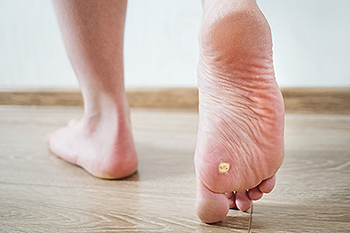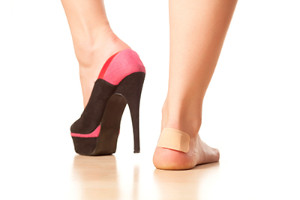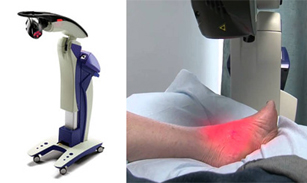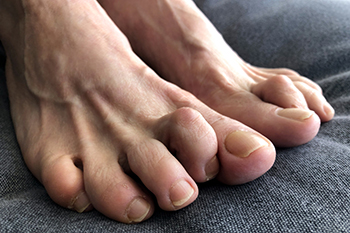Items filtered by date: November 2023
Definition and Causes of Plantar Warts

Plantar warts, often stealthy intruders on our feet, warrant a closer look to understand their nuances and origins. These warts, caused by the human papillomavirus, or HPV, appear on the soles of the feet. The HPV virus infiltrates the skin through tiny cuts or abrasions, thriving in warm, moist environments, such as communal showers or swimming pools. Plantar warts are characterized by their flat appearance and may have small black dots, often dubbed wart seeds, indicative of clotted blood vessels. The pressure applied to the soles while standing or walking makes these warts grow inward, causing discomfort. While plantar warts are generally harmless, they can be painful and stubborn. Understanding their definition and recognizing the causes including frequenting humid environments, compromised skin, or direct contact with the virus equips individuals to take proactive measures in preventing and addressing these pesky growths on their feet. If you have developed a plantar wart, it is suggested that you consult a podiatrist who can offer effective relief and treatment methods.
Plantar warts can be very uncomfortable. If you need your feet checked, contact Kimberly Woodard, DPM from Pinnacle Foot and Ankle Centers, LLC . Our doctor will assist you with all of your foot and ankle needs.
About Plantar Warts
Plantar warts are the result of HPV, or human papillomavirus, getting into open wounds on the feet. They are mostly found on the heels or balls of the feet.
While plantar warts are generally harmless, those experiencing excessive pain or those suffering from diabetes or a compromised immune system require immediate medical care. Plantar warts are easily diagnosed, usually through scraping off a bit of rough skin or by getting a biopsy.
Symptoms
- Lesions on the bottom of your feet, usually rough and grainy
- Hard or thick callused spots
- Wart seeds, which are small clotted blood vessels that look like little black spots
- Pain, discomfort, or tenderness of your feet when walking or standing
Treatment
- Freezing
- Electric tool removal
- Laser Treatment
- Topical Creams (prescription only)
- Over-the-counter medications
To help prevent developing plantar warts, avoid walking barefoot over abrasive surfaces that can cause cuts or wounds for HPV to get into. Avoiding direct contact with other warts, as well as not picking or rubbing existing warts, can help prevent the further spread of plantar warts. However, if you think you have developed plantar warts, speak to your podiatrist. He or she can diagnose the warts on your feet and recommend the appropriate treatment options.
If you have any questions please feel free to contact our office located in Port St. Lucie, FL . We offer the newest diagnostic and treatment technologies for all your foot and ankle needs.
Do Your Child's Feet Hurt?
Study Shows Dangers of Wearing High Heels

In a world where fashion often takes precedence over comfort, it is essential for women to be mindful of the long term consequences of their shoe choices. A recent study sheds light on the connection between footwear, specifically high-heels, pumps, and sandals, and the prevalence of foot and ankle pain in women. It revealed a significant association between hind foot pain in women and their past choices of shoes, particularly high-heels and pumps. Nearly 64 percent of women who reported hind foot pain had a history of regularly wearing these types of shoes at some point in their lives. The shoe types were categorized into three groups. Poor shoes were identified as high-heels, pumps, sandals, and slippers. Average shoes included hard or rubber soled shoes and work boots, and good shoes were identified as athletic and casual sneakers. Notably, more than 60 percent of women admitted to wearing shoes in the poor group, compared with two percent of men. The study's findings suggest that past shoe wear, especially choices such as high-heels, may play a significant role in generating foot and ankle pain among women. If you are experiencing pain or discomfort after wearing high heels, it is suggested that you schedule an appointment with a podiatrist for an exam, diagnose and treatment plan.
High heels have a history of causing foot and ankle problems. If you have any concerns about your feet or ankles, contact Kimberly Woodard, DPM from Pinnacle Foot and Ankle Centers, LLC . Our doctor can provide the care you need to keep you pain-free and on your feet.
Effects of High Heels on the Feet
High heels are popular shoes among women because of their many styles and societal appeal. Despite this, high heels can still cause many health problems if worn too frequently.
Which Parts of My Body Will Be Affected by High Heels?
- Ankle Joints
- Achilles Tendon – May shorten and stiffen with prolonged wear
- Balls of the Feet
- Knees – Heels cause the knees to bend constantly, creating stress on them
- Back – They decrease the spine’s ability to absorb shock, which may lead to back pain. The vertebrae of the lower back may compress.
What Kinds of Foot Problems Can Develop from Wearing High Heels?
- Corns
- Calluses
- Hammertoe
- Bunions
- Morton’s Neuroma
- Plantar Fasciitis
How Can I Still Wear High Heels and Maintain Foot Health?
If you want to wear high heeled shoes, make sure that you are not wearing them every day, as this will help prevent long term physical problems. Try wearing thicker heels as opposed to stilettos to distribute weight more evenly across the feet. Always make sure you are wearing the proper shoes for the right occasion, such as sneakers for exercising. If you walk to work, try carrying your heels with you and changing into them once you arrive at work. Adding inserts to your heels can help cushion your feet and absorb shock. Full foot inserts or metatarsal pads are available.
If you have any questions please feel free to contact our office located in Port St. Lucie, FL . We offer the newest diagnostic and treatment technologies for all your foot and ankle needs.
Understanding the Definition and Applications of MLS Laser Therapy

MLS, or Multiwave Locked System laser therapy, is an advanced and non-invasive medical technique that utilizes laser light to stimulate the body's natural healing processes. The therapy involves the use of dual wavelengths of light to penetrate tissues, reducing pain and inflammation while accelerating the healing of damaged cells. MLS laser therapy finds applications across various medical fields. It is often employed to address chronic and acute musculoskeletal conditions, such as arthritis, tendonitis, and sports-related injuries. The therapy works by improving blood flow to the affected area and promoting the production of endorphins, the body's natural painkillers. This leads to reduced pain, increased mobility, and enhanced tissue repair. In addition to pain management, MLS laser therapy is utilized in wound healing, post-operative recovery, and foot conditions. Its non-invasive nature and minimal side effects make it a valuable option for those seeking relief from various medical conditions. Understanding the definition and applications of MLS laser therapy sheds light on its significance in modern healthcare, offering an alternative approach to pain relief and healing. If you are interested in learning more about MLS laser therapy to treat your foot condition, it is suggested that you consult a podiatrist who can determine if this treatment method is right for you.
MLS Laser Therapy is a successful alternative for treating any pain you may be experiencing related to certain podiatric conditions. If you are interested in MLS Laser Therapy, consult with Kimberly Woodard, DPM from Pinnacle Foot and Ankle Centers, LLC . Our doctor will assess your condition and provide you with quality foot and ankle treatment.
MLS Laser Therapy
Multiwave Locked System (MLS) Laser Therapy is a patented, FDA-cleared technology that helps relieve pain and inflammation from a number of podiatric conditions, including:
- Heel Pain
- Plantar Fasciitis
- Sports Injuries
- Wounds
- Achilles Tendonitis
- Arthritis
- Neuropathy
- Neuromas
MLS Laser Therapy is an ideal alternative to surgery and prescription medication, as it has no negative side effects and encourages accelerated healing. Among its many clinical benefits, MLS Laser Therapy also:
- Reduces swelling due to bruising or inflammation
- Blocks pain
- Reduces formation of scar tissue
- Improves nerve function
If you have any questions, please feel free to contact our office located in Port St. Lucie, FL . We offer the newest diagnostic and treatment technologies for all your foot care needs.
Causes and Symptoms of Hammertoe

Hammertoe is a common foot condition that can cause discomfort and pain. It occurs when there is an imbalance in the muscles, tendons, or ligaments that normally hold the toe straight. One of the leading causes of hammertoe is wearing ill-fitting shoes, especially those with high heels or narrow, pointy toes, which force the toes into an unnatural position. Additionally, genetics can play a role, as some individuals may be more prone to developing hammertoe due to their family history. Arthritis and foot injuries are other contributing factors. The symptoms of hammertoe are quite noticeable. The affected toe tends to bend at the middle joint, resembling a hammer, hence the name. This deformity can lead to pain, corns, calluses, and discomfort while walking. Over time, hammertoe may become rigid, making it even more challenging to manage. Early detection and appropriate footwear choices are important for addressing this condition effectively. If you have the symptoms of hammertoe, it is suggested that you consult a podiatrist who can effectively diagnose and offer treatment options for this condition.
Hammertoe
Hammertoes can be a painful condition to live with. For more information, contact Kimberly Woodard, DPM from Pinnacle Foot and Ankle Centers, LLC . Our doctor will answer any of your foot- and ankle-related questions.
Hammertoe is a foot deformity that affects the joints of the second, third, fourth, or fifth toes of your feet. It is a painful foot condition in which these toes curl and arch up, which can often lead to pain when wearing footwear.
Symptoms
- Pain in the affected toes
- Development of corns or calluses due to friction
- Inflammation
- Redness
- Contracture of the toes
Causes
Genetics – People who are genetically predisposed to hammertoe are often more susceptible
Arthritis – Because arthritis affects the joints in your toes, further deformities stemming from arthritis can occur
Trauma – Direct trauma to the toes could potentially lead to hammertoe
Ill-fitting shoes – Undue pressure on the front of the toes from ill-fitting shoes can potentially lead to the development of hammertoe
Treatment
Orthotics – Custom made inserts can be used to help relieve pressure placed on the toes and therefore relieve some of the pain associated with it
Medications – Oral medications such as anti-inflammatories or NSAIDs could be used to treat the pain and inflammation hammertoes causes. Injections of corticosteroids are also sometimes used
Surgery – In more severe cases where the hammertoes have become more rigid, foot surgery is a potential option
If you have any questions please contact our office located in Port St. Lucie, FL . We offer the newest diagnostic and treatment technologies for all your foot and ankle needs.

